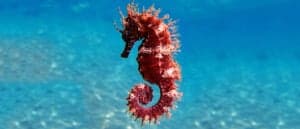Seahorses are one of the most recognizable creatures in the entire world. These fish have a distinct shape that resembles the head and neck of a horse. Seahorses have long snouts and even a prehensile tail that they use to stay anchored in place while looking for food. They vary in size, from less than an inch long to just about a foot in extraordinary cases (the largest seahorse can reach nearly 14 inches long). Their size begs the question, what do seahorses eat?
Fortunately, there are many tiny foods to be found in the ocean! We’ll show you the various meals that seahorses eat along with how they manage to capture foods despite their diminutive size.
What Foods Do Seahorses Eat?

Seahorses eat crustaceans, phytoplankton, algae, and zooplankton. These fish are omnivores that use their snout to consume their meals. Seahorses have a unique physiology that requires them to eat quite often, albeit in small amounts.
The foods that seahorses are most likely to consume include:
- Krill
- Sea snails
- Zooplankton
- Phytoplankton
- Algae
- Mysis shrimp
- Caridean shrimp
- Caprellidae
- Amphipods
- Copepod
- Rotifers
- Cleaner shrimp
- Daphnia
- Brine shrimp
- Ghost shrimp
- Red shrimp
- Grass shrimp
- Guppies
- Glass shrimp
The list of creatures that seahorses eat makes it clear that they demonstrate a preference for crustaceans, especially shrimp. It is important to keep in mind that seahorses are very small fish, and the creatures they eat are much smaller than them. The brine shrimp and sea snails consumed by the seahorse are less than half an inch in length, and their larvae are even smaller.
How Much Do Seahorses Eat?
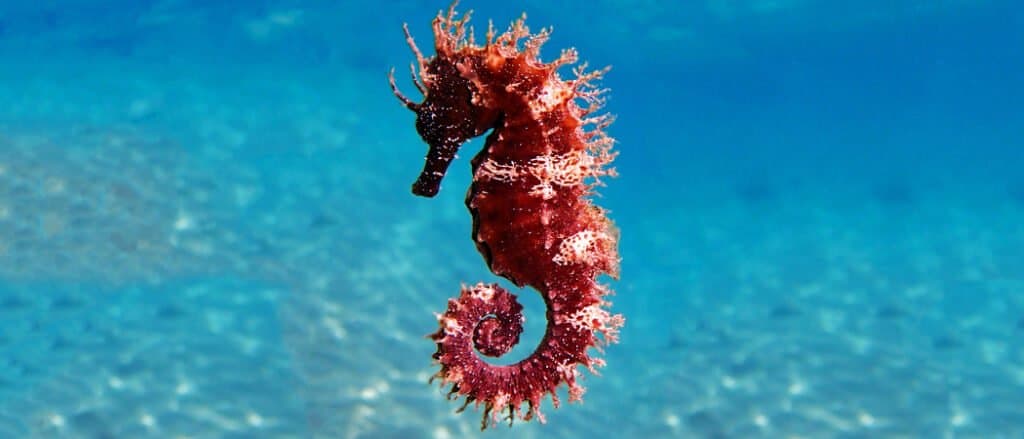
Adult seahorses can eat up to 50 times per day!
©Vojce/Shutterstock.com
The seahorse is a relatively small animal, with the largest variety of them being about 12 inches long and the smallest of them being less than 1 inch long. They are also among the slowest fish in the ocean, so it would stand to reason that they do not require a lot of food.
Yet, the seahorse lacks a stomach within its digestive system, meaning it must constantly eat food to maintain its energy levels.
Seahorses must eat quite often. On average, they have to eat between 30 and 50 times per day. Although the amount that seahorses eat is relatively small, the fact remains that their frequent eating habits require a fair amount of hunting to keep their dietary needs met.
How Do Seahorses Hunt Food?
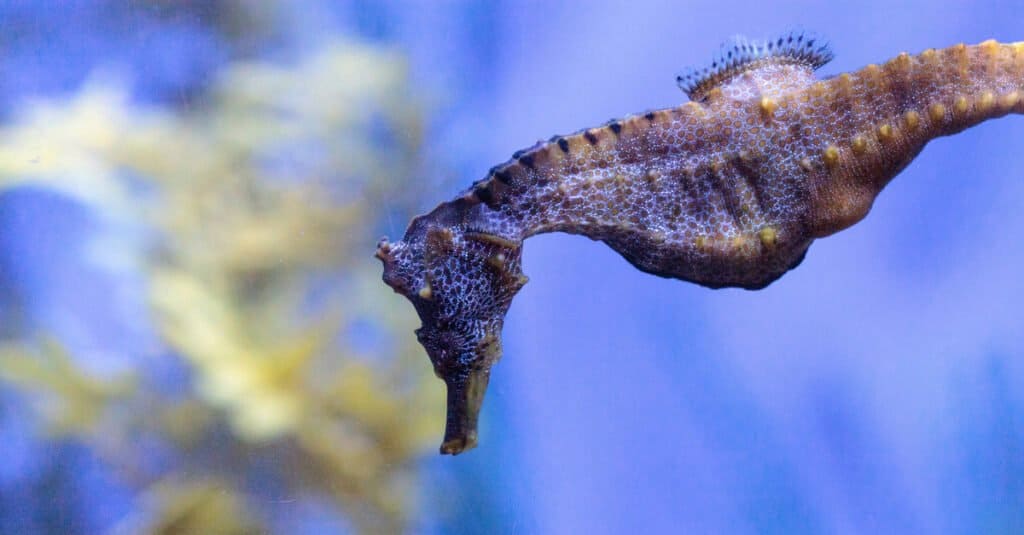
Seahorses use their great sight to identify prey and then suck them up with their snout.
©SunflowerMomma/Shutterstock.com
Seahorses are very slow swimmers, and they are not very large fish, so hunting might seem almost impossible for them. However, they are adept at fulfilling their food requirements.
It all starts with their amazing sense of sight that they use to identify choice foods that suit their dietary needs. They can track small crustaceans that lack the senses to avoid them and then snatch them into their mouths using a vacuum force in their snout.
They would make for decent hunters if not for their poor mobility. As such, seahorses take another approach to finding the food they need. They use their prehensile tails to grip onto a stable anchor point like coral or another form of camouflage like vegetation. Afterward, they wait for food to float by before ambushing it and eating it.
The shape of their head helps when they spring forth at prey, giving these otherwise slow creatures the ability to claim a meal. The seahorse is not an incredibly cunning predator, but they are apparently very effective because many of them eat several dozen small shrimp each day.
What Do Baby Seahorses Eat?
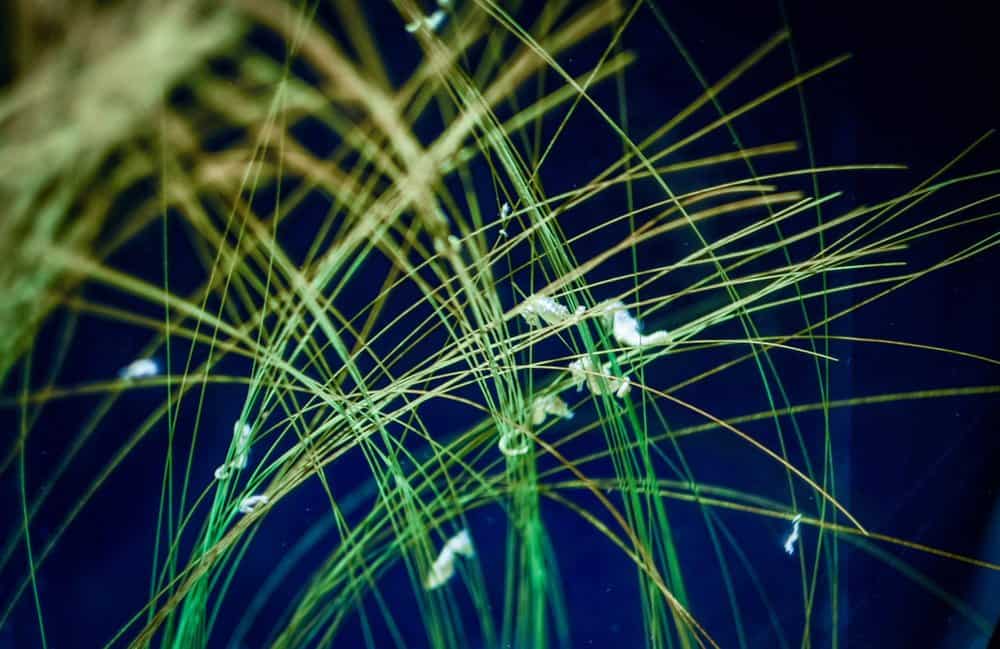
Baby seahorses eat small crustaceans like brine shrimp and copepods.
©Nicole Griffin Ward/Shutterstock.com
Baby seahorses eat brine shrimp, rotifers, and other exceptionally small crustaceans. Like many other growing creatures, they have to eat a lot in their early lives.
A baby seahorse can consume a great deal of food, upwards of 3,000 small copepods during a 10 to 12-hour period. The number of creatures consumed is vast, but it’s important to consider two factors.
First, seahorses do not have stomachs, so babies need to eat a lot of food to get the nutrition they need to continue growing. Second, the size of these creatures is incredibly small, some as small as 11mm.
Seahorses will consume their prey whole, even as babies. They have no teeth, so they just suck the creature in through their snout and swallow.
All in all, baby seahorses eat a great number of various creatures while they are young, but they often fall victim to other creatures before reaching their full size. In fact, less than one in a thousand lives long enough to reach adulthood.
What Predators Eat Seahorses?
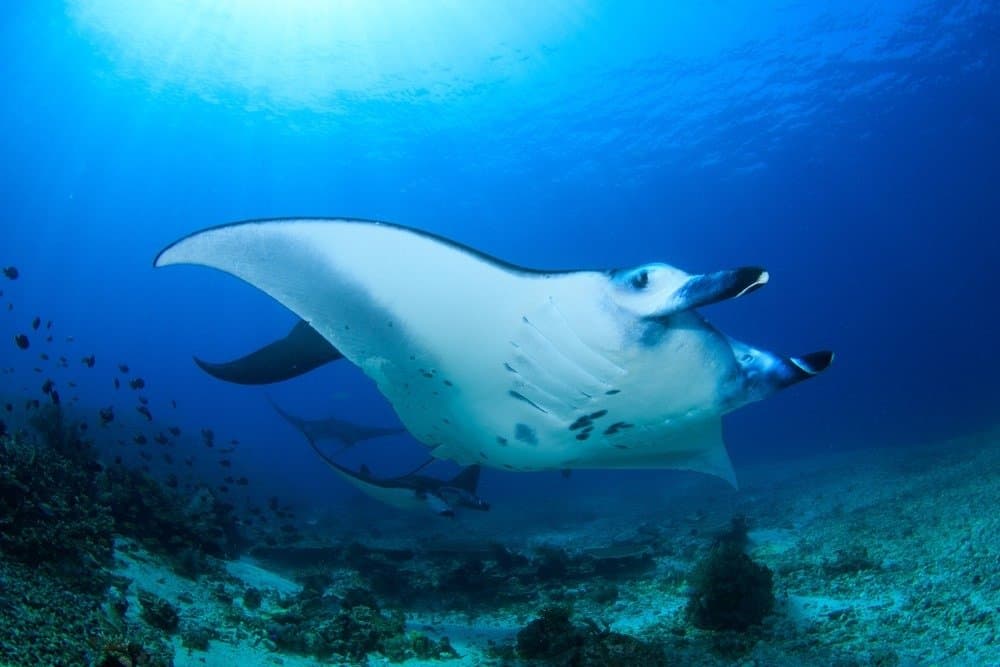
Manta rays can make quick work of seahorses.
©SergeUWPhoto/Shutterstock.com
As we have said, seahorses have many factors working against them in the ocean. They are among the slowest fish in the ocean, they have no defensive measures against actual predators, and if they get caught outside of cover, they are easy to pick off.
One thing they have working for them is their ability to camouflage themselves. They can use their shape, size, and color to blend into the background and keep themselves safe from any predators, especially those that rely upon their sight to hunt.
Nevertheless, seahorses are an easy meal for predators, even ones that are not that ambitious. As such, it’s common for seahorses to fall victim to a wide variety of creatures, including:
All these creatures are better adapted to attack than seahorses are to defend. As we’ve already mentioned, the vast majority of seahorses are killed as juveniles, but many are still killed as adults.
Interestingly, humans do not kill seahorses and eat them often, but they are considered a delicacy in some parts of the world. They also harvest them for medicinal uses. Currently, humans represent the greatest current threat to seahorse populations.
Seahorses are beautiful creatures that are hard to mistake in the ocean. They have a wide range around the world, bringing them into contact with many types of other fish, crustaceans, and other foods. Seahorses are small fish that have big appetites because of their digestive system, so they’re simultaneously some of the smallest fish but also the most frequent eaters.
One thing is for certain, these fish are very interesting, especially when you consider their eating and reproduction!
The photo featured at the top of this post is © Antonio Martin/Shutterstock.com
Thank you for reading! Have some feedback for us? Contact the AZ Animals editorial team.




